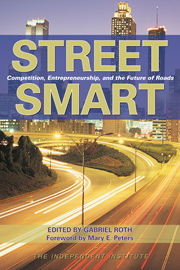More than 39,000 people were killed and 1.8 million injured in traffic accidents last year. The economic cost of these crashes was approximately $140 billion. A substantial number of the crashes involved drivers—and vehicles—that shouldn’t have been on the road.
Many solutions to the carnage have been offered over many years. One obvious solution has been avoided. Assign responsibility for vehicle safety inspections and licensing drivers to the one institution with the most to gain from keeping bad drivers and unsafe cars off the road: the insurance industry. If we truly believe that only capable, responsible drivers and safe cars should be on the road, then it’s time to try a new approach.
Employees at the state (any state) motor vehicle division, good people all, will give virtually anyone with two forms of identification a driver’s license so long as they are not seriously vision impaired and are able to pass a multiple-choice exam and minimum proficiency driving test. Their responsibility ends there; they have no stake in what happens after those drivers hit the road. Auto insurers, on the other hand, care only about what happens when those drivers get behind the wheel.
If auto insurers had the job of licensing drivers and registering vehicles—a role, incidentally, that insurers have in the maritime industry—they would be forced to adopt what I refer to as the ”Disneyland” model. In Disneyland, customers are covered by the company’s liability insurance. Consequently, to reduce risk the management restricts who may use which facilities and under what circumstances. For instance, in order to ride the California Screamin’ roller coaster, you must be at least four feet tall and should not be pregnant, have high blood pressure or suffer from heart, back or neck problems.
Since the business is held strictly liable for any injuries suffered by those entering the park, management makes every effort to enforce the park’s safety rules.
Private licensing and registration would work the same way. Because they would be insuring the drivers and cars they license, insurance companies would be vigorous in their testing and car-safety requirements, letting only qualified individuals venture out onto the roadways. They would be more likely to ferret out those unqualified to drive, from those whose driving abilities have become compromised with age or habitual substance abuse to those who have been ticketed on more than one occasion for reckless or aggressive driving. Such high-risk individuals are now cut far too much slack in most states.
Insurers also would be more likely to develop methods to allow such drivers back on the road when specific criteria are met. For instance, insurers might re-license and insure reformed DWI abusers if they use only vehicles equipped with devices that disable the ignition when alcohol is detected in the driving cabin.
The “Disneyland” model would also reduce the number of uninsured and underinsured driving on the roads, by reducing the ambiguity concerning who will be responsible for damages.
Today, an estimated 14% of all motorists operate uninsured vehicles. An even larger number of vehicles are grossly underinsured. Most of the 44 states requiring auto liability insurance (Alabama, Mississippi, New Hampshire, Tennessee, Virginia and Wisconsin do not) allow absurdly low minimum coverage—in Arizona, where I live, the minimum is $15,000/$30,000/$10,000. This means an insurer will cover bodily injury damages only up to $15,000 for a single victim, $30,000 for multiple victims, and $10,000 for vehicle property damage. Considering that 85% of crashes involve multiple vehicles, and that a single fatality costs an estimated $1 million or more, this is woefully inadequate.
Under the current system, private insurance companies have little incentive to stop people from buying inadequate levels of insurance, since damages caused by underinsured drivers are capped and damages caused by uninsured drivers are borne by either the uninsured driver or the victim. Under a private licensing, registration and insurance system, insurers would make sure that all vehicles have adequate insurance coverage.
Highway crashes remain the leading cause of death for the age group four through 34, ranking above everything else, from cancer and HIV to poisoning, drowning and suicide. We can and should do better.
Right now we rely on government employees’ and contractors’ “devotion to duty” as the main motivation for licensing only qualified drivers, registering only safe and properly functioning cars, and enforcing mandatory auto insurance laws. They are no doubt devoted to duty—but the result is a system in which the primary incentive is to follow procedure and rules, not reduce unnecessary risk.
The market’s “pursuit of profit” would introduce a different and better set of incentives. Why not give it a try?








